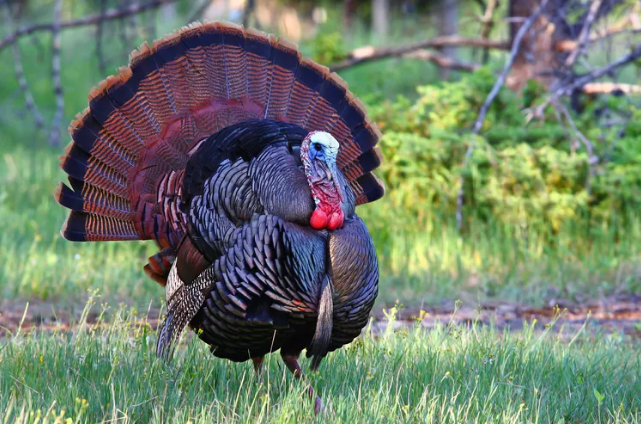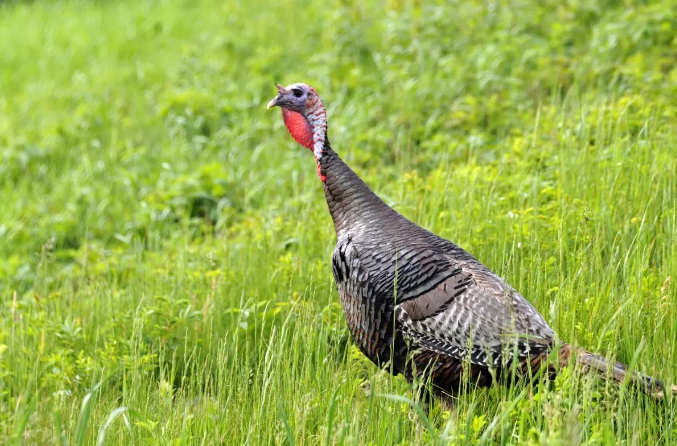The turkey is a large bird in the genus Meleagris, native to North America. There are two extant turkey species: the wild turkey (Meleagris gallopavo) of eastern and central North America and the ocellated turkey (Meleagris ocellata) of the Yucatán Peninsula in Mexico.
Races of the common turkey found today in Mexico and in the southeastern and southwestern United States differ slightly in feather markings and in rump color, but all are basically dark, with iridescent bronze and green plumage. Let us talk about male and female turkeys.
Male Turkey
Males of the two turkey species have a distinctive fleshy wattle, called a snood, that hangs from the top of the beak. They are among the largest birds in their ranges. As with many large ground-feeding birds the male is bigger and much more colorful than the female.
Adult males have a naked, heavily carunculated (bumpy) head that is normally bright red in color but turns to white overlaid with bright blue when the birds are excited.
Male turkeys, known as toms or gobblers may be 130 cm (50 inches) long and weigh 10 kg (22 pounds), though average weight is less.

Toms are the larger and heavier with muscular physique. They have a body that’s designed for strength, with thicker legs and a wider chest. The head and neck of the Toms are significantly longer than those of female turkeys (hens). The head and neck region of a tom turkey also feature colorful and prominent wattles and caruncles.
The plumage of the Toms exhibit vibrant, iridescent feathers with array of patterns and colors. During the breeding season, their plumage reaches its peak brilliance. The feathers become a dazzling display of metallic hues and bold patterns.
Male turkeys have a more aggressive, territorial and vocal behavior. They are the showmen of the turkey world, especially during the breeding season. Toms engage in elaborate courtship displays to attract the attention of female turkeys (hens). These displays involve puffing up their feathers, fanning their tails into an impressive display, and making resonant gobbling sounds.
Outside of the breeding season, toms may be found in smaller groups or even solitary, depending on the availability of resources and their territorial behavior. They establish and defend territories, often engaging in confrontations with other males to secure their turf.
Female Turkey
Female turkeys, often referred to as hens generally weigh only half as much as the males and have less warty heads than do the males. Their bodies are built for efficiency rather than bulk, featuring a more slender and streamlined shape. Although domesticated strains of the common turkey, developed for their fine-tasting flesh, may be much heavier.
Unlike toms, they do not possess the long, colorful wattles and caruncles on their heads and necks, nor do they have the prominent beard that some toms display.
Unlike the vibrant and iridescent feathers of toms, hens have more subdued and cryptic colors in their feathers. This muted appearance serves a practical purpose, as it helps hens blend into their surroundings, especially during the nesting period when they are most vulnerable.

Hens are characterized by their calmer and less vocal behavior compared to toms. They tend to be less aggressive and territorial.
After mating with a tom, hens take on the responsibility of incubating the eggs. They construct nests on the ground, where they lay and carefully tend to their eggs. This incubation period, which lasts about 28 days, requires hens to maintain the proper temperature and humidity levels to ensure the development of healthy embryos. Once the poults hatch, hens continue to protect and nurture them until they are old enough to forage on their own.
Hens tend to be more social than toms, often congregating in larger groups. These groups provide safety and support, particularly during foraging activities. The social structure among hens is less hierarchical and competitive than that of toms. Their group dynamics contribute to their overall protection and cooperation.
Male vs Female: Key Differences
| Characteristic | Male Turkey (Tom) | Female Turkey (Hen) |
|---|---|---|
| Size | Larger and heavier | Smaller and lighter |
| Body Shape | More robust and muscular | Slender and streamlined |
| Head and Neck | Longer neck and larger head | Shorter neck and smaller head |
| Wattle and Caruncles | Larger, more colorful, and more pronounced | Smaller and less colorful |
| Beard | Often has a prominent beard | Rarely has a beard |
| Feathers | Generally more colorful and iridescent | Duller, cryptic colors |
| Plumage | Often with striking patterns and colors | More subdued and camouflaged plumage |
| Spurs | Longer, more pointed spurs | Shorter, blunter spurs |
| Behavior | More aggressive, territorial, and vocal | Calmer and less vocal |
| Reproduction | Does not incubate eggs or care for poults | Incubates eggs and cares for poults |
| Mating Behavior | Engages in elaborate courtship displays | Less involved in courtship displays |
| Social Hierarchy | Often solitary or in small groups | Tends to flock together in larger groups |